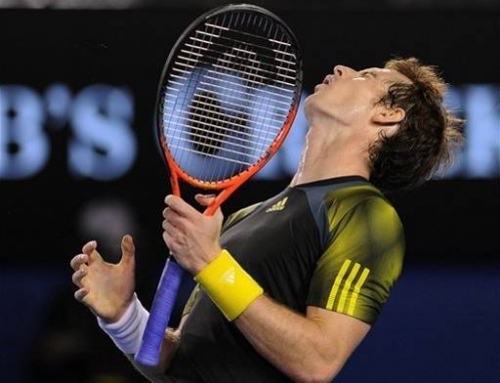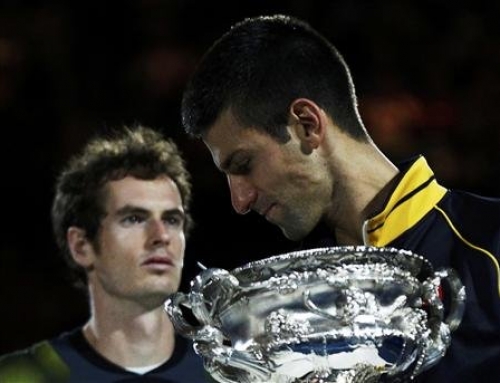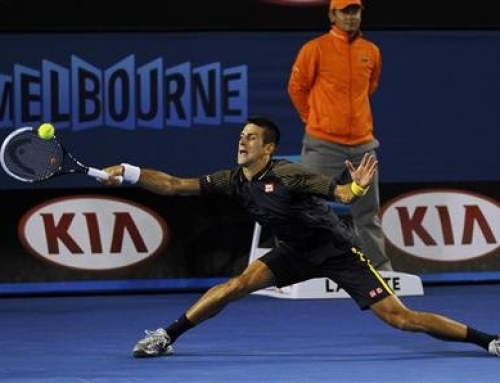Perhaps the one stat that mattered most in the semifinals is, at one point in the game, Federer had lost only 12 points in 12 service games, losing only 1 point a game. What’s important to note is Federer lost 4 of these points at a 3-1 hold in the first set when the score went to deuce twice, which means other games were mostly held at love.
This is the kind of ruthlessly efficient service games that is particularly Federer. He’s not an ace machine. He just gets in a total rhythm, where his attack and accuracy are in full flow. On such occasions, Federer just hits. His timing is not being disrupted by del Potro blasts or by Davydenko lasers.
Tsonga, for his part, didn’t start off that well. He was hitting pedestrian strokes often several meters behind the baseline. With Federer hugging the baseline and moving well, it wasn’t long before Federer was hitting drop shots, blasting Tsonga loopers, hitting behind him. With an early break, Federer relaxed and Tsonga was beginning to wonder what he needed to beat Federer. At 5-2 down, Tsonga quickly fell in a 0-40 hole, and in a lengthy rally, Tsonga pushed his backhand wide to give Federer the set in 30 minutes.
When you beat an opponent 6-2, 6-3, 6-2, and it’s the semifinal of a Slam, you’re hitting sublime. This typically happens to Federer about twice a Slam, once early on, where it’s expected to happen, and once late. In this tournament, he was extremely efficient against his long-time rival, Lleyton Hewitt. Then, he struggled against Davydenko, perhaps the hottest player coming into the Australian Open, whose precise power had beaten Federer twice before. Federer weathered that storm, and went on a 13 game tear which was less about Federer having Davydenko on a rope and more about Davydenko melting down for nearly two sets. Tsonga never came close to putting Federer in that kind of pressure.
How did Federer do it? Part of it was Tsonga. Tsonga didn’t come out hitting his shots. He was trying to establish some rallies, but Federer came out swinging his tennis racket nicely. In particular, Federer began attacking Tsonga’s backhand and playing shots behind him. It didn’t hurt that Federer was moving well and Tsonga’s attempts to play aggressive shots were often met with Federer reaching the ball comfortably, and Tsonga trying to extend the rally often invited a powerful shot by Federer to end the point.
Tsonga lacks the kind of backhand that can create havoc on Federer’s backhand. He can’t hit a hard, high topspin backhand to Federer, the one weakness that only a handful of players seem able to exploit. As hard as Tsonga hits, he’s not del Potro, nor is he Gael Monfils. Tsonga’s best opportunities often come when he gets to net and his Gallic flair comes to play, but he didn’t do enough of that effectively enough.
One reason Tsonga may not have been particularly fresh is the amount of time spent on court in his previous matches. Although Tsonga’s route to the final was nothing like Cilic’s marathon route, he had come off of two consecutive five setters, one against Nicolas Almagro and one more against Novak Djokovic, to reach the semifinal.
This seemed to affect Tsonga’s serve, which is key, because his serve seemed to get weaker as time went along. Being unable to power the serve, a key Tsonga strength, was a liability. In the end, even had Tsonga served well, tt probably wouldn’t have mattered with Federer’s ruthless efficiency.
Federer’s post-match interview revealed a couple of nuggets creating more interest than the match itself. Federer was asked if he noticed Tsonga touching his stomach as if his abdominals and Fed said he hadn’t noticed it at all. He said, in previous meetings, Tsonga has done that sometimes, where he serves big for a while, then serves slow for a while, so he thought it was merely a tactical change. He felt he played well against Tsonga, but nothing exceptional (despite 33 winners to 13 unforced errors). This sounds like such off-handed swagger, that commentators assumed he was trying to be non-chalant about how awesome he played, as if it were a mere trifle, no big deal.
He said the first set was the key to the Tsonga match. Tsonga had wanted to get a good start, and when he lost the first set, his desire dropped. At this point, Roger was already in rhythm and it was only a matter of time before he crossed the finish line.
When the questioning turned to Murray, Roger was asked whether Murray will play him more offensive, like he did against Nadal. Federer said he didn’t think Murray would play him that way. Historically, Murray has played Roger more defensively waiting for Roger to make errors. He figures Murray will try to play about medium against him, being just offensive enough, but not going on an all-out attack.
When asked whether the one day of rest he’ll get vs. the two days Murray will get, Roger said it didn’t matter. He’s not injured, so he doesn’t need an extra day to heal. The one day of rest is typical for the French and Wimbledon, and there’s a 50% chance to have one day of rest for the Australian, and there’s no rest at the US Open. Federer has played so many finals and won so many of them, that he’s adjusted to pretty much every situation. Roger always feels he gets better as time goes along and has great faith in his fitness and his ball-striking and his ability to adjust to whatever conditions he faces.
Federer thought it was more important to Murray to win the first set. He feels if he can get the first set, it will bother Murray more, but it won’t matter whether he wins the first set or not. Showing that he pays attention to matches, Federer did note that Cilic beat Murray in the first set of their semifinal encounter and came back in four sets.
I’ll preview the final in an upcoming post, but it has reached the final many expected (though some were hoping for Nadal-Federer).






![[Aussie Open Final] Can Andy Murray beat Novak Djokovic?](https://www.essentialtennis.com/wp-content/uploads/2013/01/20130126andy-500x383.jpg)
![[Day 13, Aussie Open] Bryan brothers win 13th Slam with Aussie doubles title, Kyrgios wins boys title](https://www.essentialtennis.com/wp-content/uploads/2013/01/20130125bryan-500x383.jpg)